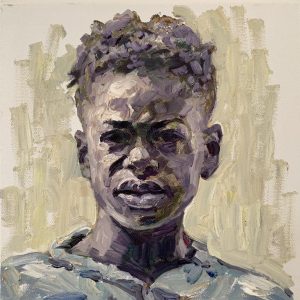The exhibition showcases Liu’s most recent paintings, primarily of children, inspired by Dorothea Lange’s Dust Bowl-era photography. Liu’s paintings depict children growing up during hard times, struggling to safeguard the joy and innocence of childhood. Though barely able to care for themselves, these children find the compassion to care for each other and for animals. Liu’s exhibition title alludes to her memory of a book she read 50 years prior when she was a student in China–Catcher in the Rye. Like “Catcher” in Salinger’s novel, it is the idealistic child who tries to keep society from falling off the edge into oblivion, both literally and metaphorically.
Hung Liu is no stranger to the loss of childhood. She endured forced “re-education” working 364 days/year in the wheat fields of the Chinese countryside during Mao’s Cultural Revolution. Her own father was placed in prison for fighting against the communists, and her mother destroyed their family photographs to protect them from governmental retaliation. Hung met her father for the first time when she was 46, shortly before he died. Because her own family photographs had been taken from her, Hung has devoted her artistic career to collecting photographs of dispossessed people such as these children, memorializing her adopted “family” in her paintings.
This major exhibition of Liu’s paintings at Turner Carroll foreshadows two highly anticipated Hung Liu retrospective exhibitions at the Ullens Art Center in Beijing (2019), and the Smithsonian Institution’s National Portrait Gallery (2021).
Liu arrived in the U.S. from China in 1984 and embraced the idea of artistic freedom. She had been trained as a Social Realist painter, and pushed the envelope of what was acceptable to the Chinese government from her years at the Central Academy of Art in Beijing. Artist David Hockney noted her tenacity in his China Diaries, in which he wrote Hung Liu’s subject matter “surely would not have been permitted during the Cultural Revolution.” Her painterly style developed as a method of challenging the strict confines of her training in China; her practice of painting evolved to express freedom through washes of color on canvas and drips of paint. From 1984 to 2015, Liu depicted primarily Chinese subjects, from prostitutes and concubines to peasants and laborers, using historic photographic collections as source material to explore the struggles and strength of the people in her own country who were displaced by political or natural forces. Since 2015, when Liu developed an affinity for Dorothea Lange’s Dust-Bowl era photography, she has painted American stories of trial and perseverance.
Opening Reception Friday, July 19, 2019 from 5 to 7pm; brief comments by Hung Liu at 6pm.

